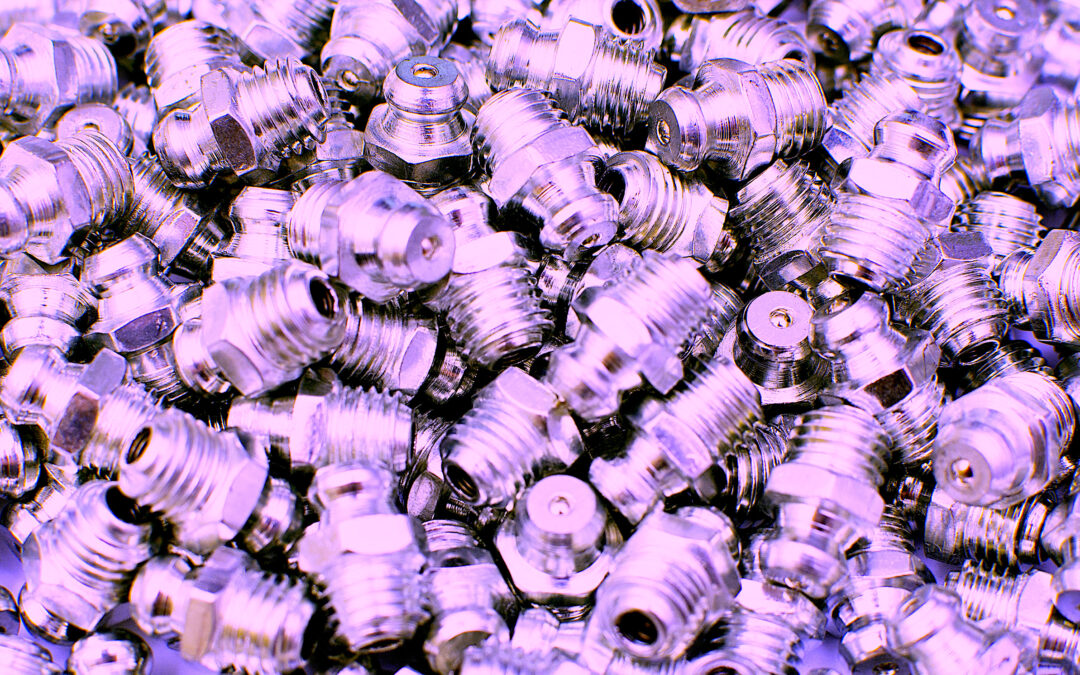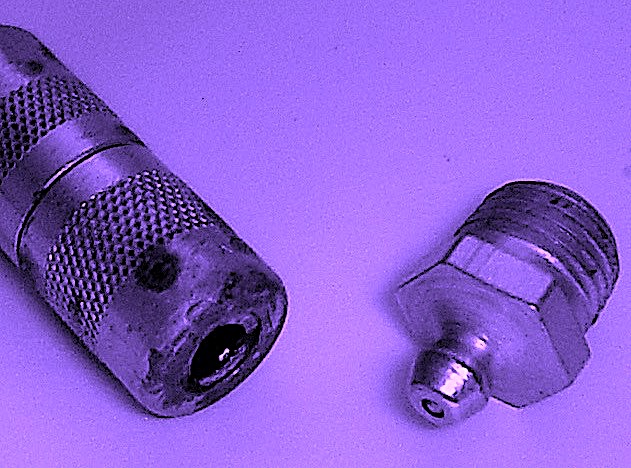The lowliest and most ubiquitous device in the world of lubrication recently celebrated its centennial anniversary. Designed as a simple, yet efficient mechanical gateway device, the grease nipple has only one job: to connect to a manual grease-delivery gun and provide a protected one-way access to the bearing cavity for filling purposes (see image below).
SOME LUBRICATION-WORLD HISTORY
Prior to Arthur Gulborg’s invention of the grease gun in 1918, a bearing was lubricated individually using a grease cup device. The grease cup, aptly named, resembled a large thimble-sized reservoir sitting above the bearing entry point. The reservoir, or grease cup, had a screw-in lid that upon removal allowed grease to be manually paddled in place. Once filled, the lid was partially screwed back in place. In doing so, the screw-in action would mechanically force new grease into the bearing. As the machine continued to run, the operator or designated lubricator would, at regular intervals, screw in each cup lid another few turns to re-lubricate the bearing with more grease. This time-consuming effort would repeat until the cup was empty and require manual refilling.
While working for the Alemite Die Casting and Manufacturing Co., in Chicago, IL, Gulborg had been responsible for ensuring all machine-lubrication cups were operated correctly and filled regularly.Recognizing an opportunity for increased efficiency, he set out to design the first-ever pressurized grease gun that could be directly coupled to the grease fitting and, thereby, make the grease-cup obsolete. He named his design the “Alemite High Pressure Grease System.” When it was adopted in 1918 as the greasing standard for the U.S. Army, the company made a fortune.
By 1922, Gulborg’s grease-gun design had evolved into a Push/Pump-style device that could be placed up against his newly designed button-head, compression grease fitting. This type of fitting opened under the grease-gun pressure, allowing the lubricant to flow through to the bearing point. But, as it did not afford a positive “lock on” connection, the grease-gun operator had to use both hands to keep the end of the gun positioned square to the grease fitting’s face. (That was the only way to prevent grease leakage from occurring.)
At the same time, not far away in Kenosha, WI, an eccentric Hungarian immigrant named Oscar Ulysses Zerk was busy inventing a simple nipple-shaped, spring-activated, high-pressure grease fitting. The result of Zerk’s efforts was destined to take the lubrication world by storm.
All the while, Gulborg and the Alemite Co. continued on with the development of their high- pressure grease system. They soon introduced a hand-trigger-operated grease gun that connected to the first positive-lock grease nipple (referred to as a “pin-type grease fitting.”) By 1922, Alemite’s new system was successfully being promoted for, and used on mass-produced automobiles. (Alemite’s pin-type grease fitting is still used wherever a guaranteed high-pressure leak-proof seal is required.)
In 1923, Oscar Zerk received his patent for the Zerk grease fitting and began marketing it through the Allyn-Zerk Co., of Cleveland, OH. His smaller, less expensive, more compact snap on-off ball lock design proved a worthy competitor to the more cumbersome Alemite pin-lock design. So much so that, in 1924, the Alemite Co. purchased the Allyn-Zerk Co. outright and proceeded to standardize the Zerk grease fitting for the high-pressure Alemite grease-gun systems that we know (and continue to use) today.
As a testament to its original design, the grease nipple has changed little over the past century. Ask anyone to describe a manual-lubrication system and most will immediately visualize a trigger- or lever-action grease gun connected to a Zerk grease nipple. Beware, though: Not all of today’s grease fittings are the same. Successfully employing or replacing grease fittings requires some investigation.
CHOOSE THE RIGHT FITTING FOR YOUR NEEDS
Grease nipples are extremely simple devices. Incorporating a shaped and threaded housing, ball, and retaining spring, these fittings rarely fail. Difficulty in pumping grease into the nipple usually indicates a hydraulic-lock situation caused by a problem with the bearing itself. That said, grease nipples can corrode or be physically damaged when struck. Therefore, they may need to be replaced from time to time. When this is the case, a maintainer or planner should be aware of the multiple choices that are available.
Material Choice
The most popular and least expensive grease nipple material is mild steel. In wet, humid, and/or corrosive environments, choosing a nipple made from Zinc plated steel, aluminum, stainless steel or brass may make for a better decision. Fittings made from monel are recommended in highly corrosive or caustic environments.
Thread Choice
Depending on where the machinery was made or specified, grease nipple threads may be imperial or metric. Depending on the size and application, the thread may be a straight (parallel) or taper thread; British Pipe, National Pipe or Unified thread. When in doubt, use a grease fitting thread gauge or a set of thread pitch gauges to determine the correct thread size. Fitting an incorrect threaded nipple can cross thread the bearing and cause grease leakage to occur.
Note: for light duty applications, non-threaded drive fittings are available
Style Choice
Depending on access to the grease nipple the fitting style may need to be considered. Most grease nipples are straight (directly lined with the bearing entrance). For poor-access areas, angled grease nipples may prove advantageous. Grease nipples can be purchased in 90-, 60-, and 45-degree angles.
Extended-barrel nipples can be purchased when reach is a problem. If protrusions of any type interfere, non-protruding or flush grease nipples can be employed.
Specialty Fittings
For heavy, high-powered machinery, a large button-head fitting (sometimes referred to as a DIN fitting) is available. This is a positive-lock design that will require its own grease-gun applicator device.
Where absolutely no leakage is allowed, the original Alemite pin-lock fitting is still available. Like the button-head fitting, though, it will require a specialized grease-gun applicator device.
An air-vent, or breather-style, grease fitting can be purchased for closed gearboxes transmissions, etc.
Pressure-relief grease fittings serve to relieve internal bearing pressure where continued positive internal pressure can cause problems.
Hydraulic-shut-off grease fittings are designed to restrict grease flow at a designed pressure to protect the bearing seal from rupture during the filling operation.
THE FINAL WORD
When manual greasing is your preferred lubrication method, choosing and using the correct grease nipple is very much a RAM (reliability, maintenance, availability) best practice. So, don’t just think of the lowly nipple as something that’s basically been doing the same job, the world over, for 100 years: Think of this fitting as an important, engineered choice that can ensure a bearing is always ready to receive lubricant.TRR
ABOUT THE AUTHOR
Ken Bannister has 40+ years of experience in the RAM industry. For the past 30, he’s been a Managing Partner and Principal Asset Management Consultant with Engtech industries Inc., where he has specialized in helping clients implement best-practice asset-management programs worldwide. A founding member and past director of the Plant Engineering and Maintenance Association of Canada, he is the author of several books, including three on lubrication, one on predictive maintenance, and one on energy reduction strategies, and is currently writing one on planning and scheduling. Contact him directly at 519-469-9173 or kbannister@theramreview.com.
Tags: reliability, availability, maintenance, RAM, lubricants, lubrication, grease guns, grease nipples, Alemite, Zerk
.




